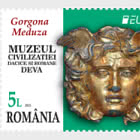Fantasies of the Flora
Romfilatelia continues the series of postage stamps dedicated to the Flora and introduces into circulation, on Tuesday, March 29, 2022, a series with a thematic philatelic premiere.
The issue is compound of four stamps, four minisheets, a First Day Cover and a special philatelic folder.
Diversity, in the natural environment, sometimes appears to be the result of an artist creating shapes and colors whose perfection misleads the viewer, who can attribute to a flower characteristics strongly perceived as belonging to another species, such as birds.
We are dealing with a natural, fanciful intervention of the environment, and, as such, the four postage stamps with images of rare beauty are presented under a defining title: Fantasies of the Flora.
The egret, the flying duck, the parrot and the angel are real images of flower species known in the world of botanists as: the egret orchid, the flying duck orchid, the angel orchid or dove orchid, the parrot orchid. To these is added a flower of a special beauty, the bird of paradise.
The scientific names in Latin will be added to the descriptions of the defining characteristics.
The egret orchid (Habenaria radiata), illustrated on the stamp with the face value of Lei 4, also known as the fringed orchid or the crane orchid, has a long, slender center surrounded by two wing-like fringes.
White shade, the flower has two petals that suggest the tail of a bird. Together with a torpedo-shaped central petal, it exposes the „bird’s” body to sight. The stems are adorned with two or three flowers and reach 15-30 cm at maturity.
The flower comes from Japan, Korea, China and Russia, where it grows in swamps and meadows, in areas protected from direct sunlight. The flowers, which appear at the end of summer, last up to four weeks.
The flying duck orchid (Caleana major), depicted on the stamp with the face value of Lei 6.50, is a small plant found in southern and eastern Australia. Its flowers look like a duck in flight. It grows at ground level, in the shade of eucalyptus forests, as well as in swampy areas. It is rarely found in mountain areas. Its name is borrowed from the English botanist George Cali. Attempts to adapt the plant to domestic cultivation have failed. The plant has a short lifespan. The insects that land on the Caleana flower are captured as if in a trap that forces them to struggle to escape, ensuring the pollination of the flower. It blooms in spring and in the summer.
The angel orchid (Peristeria elata), the pigeon orchid or the flower of the „Holy Spirit”, represented on the stamp with the face value of Lei 10, grows in Panama, where it is considered the national flower. It has a unique inflorescence and is a rare orchid. It blooms once a year. Before flowering, the buds look like praying monks. After flowering, the buds turn into „pigeons”. The flower is endangered. It grows in humid forests, at heights of up to 1,000 meters, with flowering periods between June and November, after a five-year wait.
The parrot orchid (Impatiens psittacina) is illustrated on the stamp with the face value of Lei 10.50.
Discovered in 1889 in Burma, the plant is found today in Thailand and Burma. It is a very rare plant, protected by law and cannot be exported. The flower visibly resembles a parrot taking flight. It opens its petals partially and is very sensitive to low temperatures. It has abundant branching and grows compactly to a height of about half a meter. The Thai name of the plant that blooms in October-November is „Dork Nok Khaev”.
The bird of paradise flower (Strelitzia reginae) is depicted on teh First Day Cover of the issue.
Originally from South Africa, it is a perennial, bushy-looking plant that can reach a height of up to 2 meters. The imposing flowers, colored in orange and purple, against the background of the green-gray leaves, give it a special decorative aspect. It is famous as an ornamental plant, introduced for the first time in the Royal Botanic Gardens in Kew. The epithet „reginae” (of the queen) honors the name of the British queen Charlotte of Mecklenburg-Strelitz. The plant, also widespread in California, was chosen as the official flower of the city of Los Angeles. The shape of the flowers resembles the crest and beak of an exotic bird, hence the name bird of paradise.
The philatelic folder is created into a limited run printing of 182 pieces and is equipped with the special philatelic block of four imperforated stamps of the issue along with two round perforated labels, with the First Day postmark, clearly imprinted in foiling. The special philatelic block is numbered from 001 to 182.
Romfilatelia thanks Prof. Dr. Paulina Anastasiu, Director of the „Dimitrie Brandza” Botanical Garden of the University of Bucharest for the documentary support provided for the development of this postage stamps issue.
Romania - Recommended stamp issues
WOPA+ recommended stamp issues
| Avatar - Fire and Ash |
| Issued: 03.12.2025 |
| ›New Zealand |
| 50th Anniversary of the Founding of the 24th November Bar Scout |
| Issued: 24.11.2025 |
| ›Montenegro |
| Krisjanis Valdemars |
| Issued: 02.12.2025 |
| ›Latvia |
| Sign Language - Good |
| Issued: 02.12.2025 |
| ›Bosnia and Herzegovina - Republic of Srpska |
| In Memory of the Fallen and Murdered on October 7, 2023 |
| Issued: 08.10.2025 |
| ›Israel |
| Annual Collection Folder (New York) |
| Issued: 05.12.2025 |
| ›United Nations |
| Year Set |
| Issued: 24.11.2025 |
| ›Isle of Man |
| Shipping in the 17th and 18th Centuries - Peat Shipping |
| Issued: 05.12.2025 |
| ›Netherlands |














































